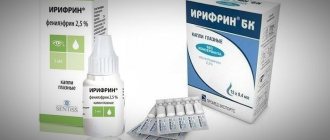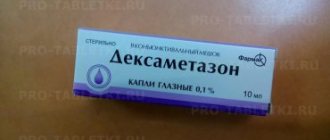Name: Diclofenac Na Pharmacological effects: Non-steroidal anti-inflammatory drug of the group of phenylacetic acid derivatives. It has a pronounced anti-inflammatory, analgesic and moderate antipyretic effect. In the treatment of rheumatic diseases, it relieves pain in the joints at rest and during movement, reduces morning stiffness and swelling of the joints, and helps to increase the range of motion in the affected joints. A lasting result develops after 1 - 2 weeks of treatment. The injection form of the drug is indicated in the initial stages of treatment of rheumatological diseases and for pain syndromes of other origins.
Diclofenac sodium - side effects:
Dyspeptic symptoms, erosive and ulcerative lesions and bleeding in the digestive canal, dizziness, allergic reactions, drowsiness, irritability are possible. In exceptional cases, burning sensations, abscesses, and necrosis of adipose tissue are possible at the site of intramuscular injection of the drug. If any unusual reactions occur, be sure to consult your doctor regarding further use of the medicine. Best before date. 2 years. Do not use the drug after the expiration date indicated on the package.
Indications for use
Diclofenac eye drops are intended for the prevention and treatment of inflammatory non-infectious processes (keratoconjunctivitis, conjunctivitis, inflammation of the conjunctiva, corneal erosion, post-traumatic complications on the cornea, photophobia after surgical interventions on the cornea).
They are used for the prevention and treatment of post-traumatic inflammation after various wounds of the eyeball (non-penetrating and penetrating) as an addition to antibacterial therapy.
The drug is effective in the prevention of miosis (constriction of the pupil) during cataract surgery, as well as inflammatory processes after surgery, for the treatment and prevention of cystoid edema of the macula (central part of the retina) after surgical removal of cataracts.
Find out what refractometry is and what eye diseases this diagnostic method is used to identify.
Whether it is necessary to remove papilloma on the eyelid, you can find out from this article.
Diclofenac sodium - contraindications:
Peptic ulcer of the stomach and duodenum, history of gastrointestinal bleeding, as well as liver and kidney diseases, third trimester of pregnancy and lactation, hypersensitivity to the drug, bronchial asthma, urticaria, acute rhinitis and other allergic reactions caused by taking non-steroidal anti-inflammatory drugs funds, children under 6 years old.
Interaction with other medications: If you are taking any other medications, be sure to tell your doctor. When used together, Diclofenac sodium increases the toxic effects of methotrexate, increases the concentration of lithium salts and digoxin in the blood plasma, reduces the effects of furosemide and antihypertensive drugs; when used simultaneously with other non-steroidal anti-inflammatory drugs, in particular with acetylsalicylic acid or glucocorticosteroids, the risk of gastrointestinal bleeding increases.
DICLOFENAC
Drug: DICLOFENAC Active substance: diclofenac ATC code: M01AB05 CG: NSAID Reg. number: P No. 010878/03 Registration date: 10/21/05 Owner of reg. credential: IPCA LABORATORIES Ltd. {India}
DOSAGE FORM, COMPOSITION AND PACKAGING
| Enteric-coated tablets | 1 tab. |
| diclofenac sodium | 50 mg |
10 pieces. — cellless contour packages (2) — cardboard packs. 10 pieces. — cellless contour packages (10) — cardboard packs.
| Extended-release film-coated tablets | 1 tab. |
| diclofenac sodium | 100 mg |
10 pieces. — cellless contour packages (2) — cardboard packs. 10 pieces. — cellless contour packages (10) — cardboard packs.
| Solution for intramuscular administration | 1 ml | 1 amp. |
| diclofenac sodium | 25 mg | 75 mg |
3 ml - ampoules (5) - cardboard packs.
3 ml - ampoules (10) - cardboard packs. DESCRIPTION OF THE ACTIVE SUBSTANCE.
The scientific information provided is general and cannot be used to make a decision about the possibility of using a particular drug. PHARMACHOLOGIC EFFECT
NSAID, phenylacetic acid derivative. It has a pronounced anti-inflammatory, analgesic and moderate antipyretic effect. The mechanism of action is associated with inhibition of the activity of COX, the main enzyme in the metabolism of arachidonic acid, which is a precursor of prostaglandins, which play a major role in the pathogenesis of inflammation, pain and fever. The analgesic effect is due to two mechanisms: peripheral (indirectly, through suppression of prostaglandin synthesis) and central (due to inhibition of prostaglandin synthesis in the central and peripheral nervous system).
Inhibits proteoglycan synthesis in cartilage.
For rheumatic diseases, it reduces pain in the joints at rest and during movement, as well as morning stiffness and swelling of the joints, and helps to increase range of motion. Reduces post-traumatic and postoperative pain, as well as inflammatory swelling.
Suppresses platelet aggregation. With long-term use it has a desensitizing effect.
When applied topically in ophthalmology, it reduces swelling and pain during inflammatory processes of non-infectious etiology.
PHARMACOKINETICS
After oral administration, it is absorbed from the gastrointestinal tract. Eating slows down the rate of absorption, but the degree of absorption does not change. About 50% of the active substance is metabolized during the “first pass” through the liver. When administered rectally, absorption occurs more slowly. The time to reach Cmax in plasma after oral administration is 2-4 hours depending on the dosage form used, after rectal administration - 1 hour, intramuscular administration - 20 minutes. The concentration of the active substance in plasma is linearly dependent on the dose applied.
Does not accumulate. Plasma protein binding is 99.7% (mainly with albumin). Penetrates into synovial fluid, Cmax is reached 2-4 hours later than in plasma.
It is extensively metabolized to form several metabolites, of which two are pharmacologically active, but to a lesser extent than diclofenac.
Systemic clearance of the active substance is approximately 263 ml/min. T1/2 from plasma is 1-2 hours, from synovial fluid - 3-6 hours. Approximately 60% of the dose is excreted in the form of metabolites by the kidneys, less than 1% is excreted unchanged in the urine, the rest is excreted in the form of metabolites in bile.
INDICATIONS
Articular syndrome (rheumatoid arthritis, osteoarthritis, ankylosing spondylitis, gout), degenerative and chronic inflammatory diseases of the musculoskeletal system (osteochondrosis, osteoarthritis, periarthropathy), post-traumatic inflammation of soft tissues and the musculoskeletal system (sprains, bruises). Pain in the spine, neuralgia, myalgia, arthralgia, pain and inflammation after operations and injuries, pain with gout, migraine, algodismenorrhea, pain with adnexitis, proctitis, colic (bilious and renal), pain with infectious and inflammatory diseases of the ENT -organs
For local use: inhibition of miosis during cataract surgery, prevention of cystoid macular edema associated with removal and implantation of the lens, inflammatory processes of the eye of a non-infectious nature, post-traumatic inflammatory process in penetrating and non-penetrating wounds of the eyeball.
DOSING REGIME
For oral administration for adults, a single dose is 25-50 mg 2-3 times a day. The frequency of administration depends on the dosage form used, the severity of the disease and is 1-3 times a day, rectally - 1 time a day. For the treatment of acute conditions or relief of exacerbation of a chronic process, a dose of 75 mg is used intramuscularly.
For children over 6 years of age and adolescents, the daily dose is 2 mg/kg.
Apply externally in a dose of 2-4 g (depending on the area of the painful area) to the affected area 3-4 times a day.
When used in ophthalmology, the frequency and duration of administration are determined individually.
Maximum doses: when taken orally for adults - 150 mg/day.
SIDE EFFECT
From the digestive system: nausea, vomiting, anorexia, pain and discomfort in the epigastric region, flatulence, constipation, diarrhea; in some cases - erosive and ulcerative lesions, bleeding and perforation of the gastrointestinal tract; rarely - liver dysfunction. When administered rectally, in isolated cases, inflammation of the colon with bleeding and exacerbation of ulcerative colitis were observed.
From the central nervous system and peripheral nervous system: dizziness, headache, agitation, insomnia, irritability, feeling tired; rarely - paresthesia, visual impairment (blurredness, diplopia), tinnitus, sleep disorders, convulsions, irritability, tremor, mental disorders, depression.
From the hematopoietic system: rarely - anemia, leukopenia, thrombocytopenia, agranulocytosis.
From the urinary system: rarely - renal dysfunction; swelling may occur in predisposed patients.
Dermatological reactions: rarely - hair loss.
Allergic reactions: skin rash, itching; when used in the form of eye drops - itching, redness, photosensitivity.
Local reactions: a burning sensation is possible at the site of intramuscular injection, in some cases - the formation of infiltrate, abscess, necrosis of adipose tissue; with rectal administration, local irritation, the appearance of mucous discharge mixed with blood, and painful defecation are possible; when used externally in rare cases - itching, redness, rash, burning; when applied topically in ophthalmology, a transient burning sensation and/or temporary blurred vision may occur immediately after instillation.
With prolonged external use and/or application to large surfaces of the body, systemic side effects are possible due to the resorptive effect of diclofenac.
CONTRAINDICATIONS
Erosive and ulcerative lesions of the gastrointestinal tract in the acute phase, “aspirin triad”, hematopoietic disorders of unknown etiology, hypersensitivity to diclofenac and components of the dosage form used, or other NSAIDs.
PREGNANCY AND LACTATION
Use during pregnancy and lactation is possible in cases where the potential benefit to the mother outweighs the potential risk to the fetus or newborn.
SPECIAL INSTRUCTIONS
Use with extreme caution in patients with a history of liver, kidney, gastrointestinal diseases, dyspeptic symptoms, bronchial asthma, arterial hypertension, heart failure, immediately after major surgical interventions, as well as in elderly patients.
If there is a history of allergic reactions to NSAIDs and sulfites, diclofenac is used only in emergency cases. During treatment, systematic monitoring of liver and kidney function and peripheral blood patterns is necessary.
Rectal use is not recommended in patients with diseases of the anorectal region or a history of anorectal bleeding. It should be used externally only on undamaged areas of the skin.
Avoid contact of diclofenac with the eyes (except for eye drops) or mucous membranes. Patients using contact lenses should use eye drops no earlier than 5 minutes after removing the lenses.
Not recommended for use in children under 6 years of age.
During treatment with dosage forms for systemic use, alcohol consumption is not recommended.
Impact on the ability to drive vehicles and operate machinery
During the treatment period, the speed of psychomotor reactions may decrease. If your vision becomes blurred after using eye drops, you should not drive a car or engage in other potentially hazardous activities.
DRUG INTERACTIONS
When used simultaneously with diclofenac, antihypertensive drugs may weaken their effect.
There are isolated reports of the occurrence of seizures in patients taking NSAIDs and quinolone antibacterial drugs simultaneously.
When used simultaneously with GCS, the risk of side effects from the digestive system increases.
With simultaneous use of diuretics, the diuretic effect may be reduced. When used simultaneously with potassium-sparing diuretics, it is possible to increase the concentration of potassium in the blood.
When used simultaneously with other NSAIDs, the risk of side effects may increase.
There are reports of the development of hypoglycemia or hyperglycemia in patients with diabetes mellitus who used diclofenac simultaneously with hypoglycemic drugs.
When used simultaneously with acetylsalicylic acid, the concentration of diclofenac in the blood plasma may decrease.
Although clinical studies have not established the effect of diclofenac on the action of anticoagulants, isolated cases of bleeding have been described with the simultaneous use of diclofenac and warfarin.
With simultaneous use, it is possible to increase the concentration of digoxin, lithium and phenytoin in the blood plasma.
The absorption of diclofenac from the gastrointestinal tract is reduced when used simultaneously with cholestyramine, and to a lesser extent with colestipol.
With simultaneous use, it is possible to increase the concentration of methotrexate in the blood plasma and increase its toxicity.
With simultaneous use, diclofenac may not affect the bioavailability of morphine, however, the concentration of the active metabolite of morphine may remain elevated in the presence of diclofenac, which increases the risk of developing side effects of the morphine metabolite, incl. respiratory depression.
When used simultaneously with pentazocine, a case of the development of a grand mal seizure has been described; with rifampicin - a decrease in the concentration of diclofenac in the blood plasma is possible; with ceftriaxone - the excretion of ceftriaxone in bile increases; with cyclosporine - increased nephrotoxicity of cyclosporine is possible.
Diclofenac sodium - additionally:
When using Diclofenac sodium, interactions with drugs from other groups must be taken into account.
Use with caution in combination with anticoagulants and antidiabetic agents, as well as in patients with liver and kidney diseases, patients with arterial hypertension, with heart failure, in the postoperative period, and in elderly patients. During drug therapy, it is necessary to monitor the functions of the liver and kidneys, and the composition of the peripheral blood. When administered intramuscularly, the course of treatment is no more than 5 days. Important! Before using Diclofenac sodium, you should consult your doctor. This instruction is intended for informational purposes only.
Indications and method of use
The drug is indicated for use in the following cases:
- If the patient has postoperative inflammation of the eye tissues.
- Against the background of the development of photophobia after undergoing keratomy.
- After injuries, foreign bodies entering the organs of vision, ophthalmological operations.
- With the development of inflammatory eye diseases of a non-infectious nature (conjunctivitis, keratitis, dacryocystitis, erosive lesions of the cornea).
For the purpose of prevention, drops are prescribed after surgical lens replacement. In this case, the medicine helps prevent cystoid edema in the area of the optic nerve.
The dosage of the medication and the duration of its use are determined by the doctor in each individual case. According to the instructions in the instructions, adults instill this remedy 3 to 5 times a day, 1-2 drops alternately in both eyes.
If the patient has undergone ophthalmic surgery, Diclofenac can be administered hourly for 5 postoperative hours, after which the standard dosage regimen is restored.
In pediatrics, eye drops are used only to treat children over 12 years of age. Doses for younger patients are set individually.
The duration of the therapeutic course is determined by the type of diagnosis. Most often, the solution is used no longer than 3-4 weeks. If the desired effect is absent, or the patient’s condition worsens, treatment with Diclofenac is suspended and a doctor is consulted.









